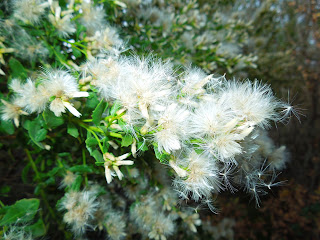Hike along forest roads, going gently downhill to find this 83 foot waterfall! The kids can do this if they can walk 5 miles round trip.
I read about this waterfall on a blog last year but when I searched for more information, even the
World Waterfall Data Base didn't show it. My book of California waterfalls didn't list it either. I have tried before and this hike was another attempt. I headed out without specific information other than where to begin the hike, the name of the creek, and that you follow old logging and forestry roads; no other helpful directions.
My victorious hike surprised me a little with
snow left on the ground from fairly recent stormy weather, but I had my jacket and gloves, gaiters, waterproof boots, and enthusiasm. Plus gas is expensive and I wasn't about to turn back now!
Holy Surprises! I found three mounds of
fresh bear scat in a short distance so I talked loudly to the bears while hiking down the muddy and snowy road. The sounds of snapping branches behind my camera-bug pauses kept me alert.
My day was chilly enough to wear my jacket and gloves, but the sky was blue with floating clouds and the tree tops didn't even hint at the snow carpeting the forest floor!
Down the road, as my elevation declined, the snowy floor dried and the trees thinned.
I heard the rushing sounds and at last I made it to
Canyon Creek, giddy with hope that I had time to scout out the creek from here and find the falls. I had no idea how far or which direction they may be so I headed east, upstream. It's a beautiful season, but the leaves were thickly blanketing the "trail" and being so wet, were a bit slippery. The creek was a symphony for me, and I hoped it was a waterfall creating the commotion.
 |
SUCCESS! As you can see from the photo, serendipity and intuition led me there!
|
I saw the top first, and with water levels being what they are right now, crossing back and forth trying to find a perfect place to photograph the falls was nothing like the challenge I had expected! My foot sank a little deep and the boot can only do so much to keep me dry! There is an
active mining claim here and the trail was decent, although buried in wet leaves.
This is looking back downstream from the waterfall. There is snow still in this heavily shaded area, and the temperature reflected it.
 |
| The woods are colorful now rather than all green. |
I stopped here for photos and heard breaking branches in the gully behind me so I gave the bears a yell, looked around, took another snapshot, and returned to the car. I was elated to have found this prize waterfall hike and am happy to share it with you!
 |
| Forks in the road are marked with waypoints and arrows or notes. |
Directions:
Clock your mileage from the intersection in Georgetown where you turn onto Wentworth Springs Road (like any old town "Main Street") and go 10.5 miles. Turn right at the sign for the Bald Mountain Staging Area, but pull in on the right at the first dirt road and find an out of the way place to park. You will hike down that road. It is gated and crosses private lumber property for a mile or so. There are not "No Trespassing" signs, and it is marked with a small company sign.
I hiked further but the trail above is
4.9 miles out and back, after I took out my other detours.
 |
| Difficulty: Moderate due to elevation and to the creek side trail being almost a bushwhacking. Plus you cross the creek at least once to see the falls, really twice for a nice view. |
 |
This is a summary of my hike. I certainly took my time, stopped to eat and photograph.
This area has OHV areas closed for the winter, but available post snowy season. There is ample parking for horse trailers too and equestrain traffic is welcome. |
I caution you to use your discretion about hiking in across private property. And above all, please be responsible.
There are no restrictions about hiking on a mining claim, but don't pan for gold!
Thanks for stopping by and HAPPY TRAILS!







































































